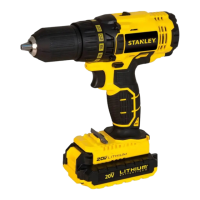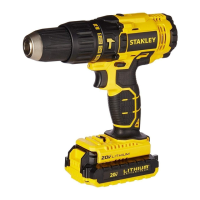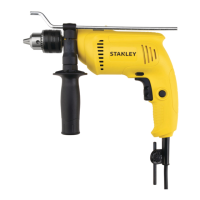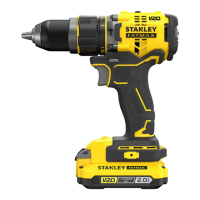24 • ENGLISH
rotational direction of the tool and also serves as a
lock off button.
f To select forward rotation, release the trigger switch
and depress the forward/reverse control button on the
right side of the tool.
f To select reverse, depress the forward/reverse control
button on the left side of the tool.
f The center position of the control button locks the tool
in the off position. When changing the position of the
control button, be sure the trigger is released.
Adjusting torque control (Fig. E)
This tool is fitted with a torque adjustment collar (3)
to select the operating mode and to set the torque for
tightening screws. Large screws and hard work piece
materials require a higher torque setting than small screws
and soft work piece materials.
f For drilling in wood, metal and plastics, set the collar
to the drilling position symbol .
f For screwdriving, set the collar to the desired setting.
If you do not yet know the appropriate setting, proceed
as follows:
a. Set the collar to the lowest torque setting.
b. Tighten the first screw.
c. If the clutch ratchets before the desired result
is achieved, increase the collar setting and continue
tightening the screw. Repeat until you reach
the correct setting. Use this setting for
the remaining screws.
Dual range switch (Fig. F)
The dual range feature of your drill allows you to shift
gears for greater versatility.
f To select low speed, high torque setting (position 1),
turn tool off and permit to stop. Slide gear shifter
button (4) away from the chuck.
f To select the high speed, low torque setting (position 2),
turn tool off and permit to stop. Slide gear shifter button
back toward the chuck.
Note: Do not change gears when tool is running.
If you are having trouble changing gears, make sure
that the dual range gear button is either completely
pushed forward or completely pushed back.
Keyless chuck (Fig. G)
Warning! Make certain the battery pack is removed to prevent
tool actuation before installing or removing accessories.
To insert a drill bit or other accessory:
1. Grasp the chuck (5) and rotate it in the counterclockwise
direction, as viewed from the chuck end.
2. Insert the bit or other accessory fully into the chuck,
and tighten securely by rotating the chuck in the
clockwise direction as viewed from the chuck end.
Warning! Do not attempt to tighten or loosen drill bits
(or any other accessory) by gripping the front part of the
chuck and turning the tool on. Damage to the chuck and
personal injury may occur when changing accessories.
Screw driving
f For driving fasteners, the forward/reverse button
should be pushed to the left.
f Use reverse (button pushed to the right) for removing
fasteners.
Note: When moving from forward to reverse, or vice
versa, always release the trigger switch first.
Drilling
f Use sharp drill bits only.
f Support and secure work properly, as instructed in the
Safety Instructions.
f Use appropriate and required safety equipment, as
instructed in the Safety Instructions.
f Secure and maintain work area, as instructed in the
Safety Instructions.
f Run the drill very slowly, using light pressure, until
the hole is started enough to keep the drill bit from
slipping out of it.
f Apply pressure in a straight line with the bit. Use
enough pressure to keep the bit biting but not so much
as to stall the motor or deflect the bit.
f Hold the drill firmly with two hands, one hand on
the handle, and the other gripping the bottom around
the battery area or the auxiliary handle if provided.
f Do not click the trigger of a stalled drill off and on
in an attempt to start it. Damage to the drill can result.
f Minimize stalling on break through by reducing pressure
and slowly drilling through the last part of th hole.
f Keep the motor running while pulling the bit out of a
drilled hole. This will help reduce jamming.
f Make sure switch turns drill on and off.
Drilling in wood
Holes in wood can be made with the same twist drill bits
used for metal or with spade bits. These bits should be
sharp and should be pulled out frequently when drilling to
clear chips from the flutes.
Drilling in metal
Use a cutting lubricant when drilling metals. The
exceptions are cast iron and brass which should be drilled
dry. The cutting lubricants that work best are sulfurized
cutting oil or lard oil.
Drilling in masonry
Use carbide tipped masonry bits. Refer to Drilling section.
Keep even force on the drill but not so much that you crack
the brittle material. A smooth, even flow of dust indicates
the proper drilling rate.
